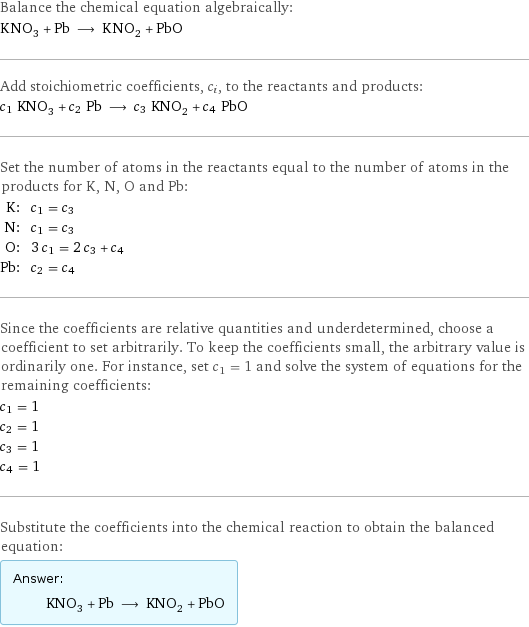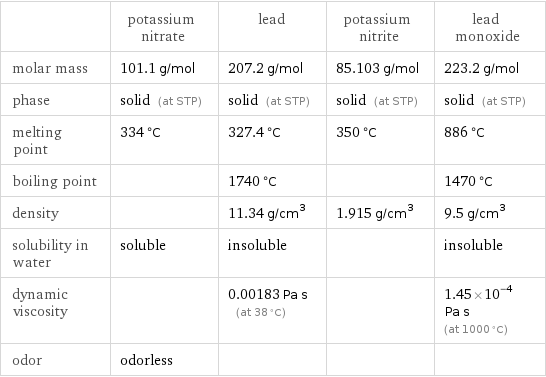Input interpretation

KNO_3 potassium nitrate + Pb lead ⟶ KNO_2 potassium nitrite + PbO lead monoxide
Balanced equation

Balance the chemical equation algebraically: KNO_3 + Pb ⟶ KNO_2 + PbO Add stoichiometric coefficients, c_i, to the reactants and products: c_1 KNO_3 + c_2 Pb ⟶ c_3 KNO_2 + c_4 PbO Set the number of atoms in the reactants equal to the number of atoms in the products for K, N, O and Pb: K: | c_1 = c_3 N: | c_1 = c_3 O: | 3 c_1 = 2 c_3 + c_4 Pb: | c_2 = c_4 Since the coefficients are relative quantities and underdetermined, choose a coefficient to set arbitrarily. To keep the coefficients small, the arbitrary value is ordinarily one. For instance, set c_1 = 1 and solve the system of equations for the remaining coefficients: c_1 = 1 c_2 = 1 c_3 = 1 c_4 = 1 Substitute the coefficients into the chemical reaction to obtain the balanced equation: Answer: | | KNO_3 + Pb ⟶ KNO_2 + PbO
Structures

+ ⟶ +
Names

potassium nitrate + lead ⟶ potassium nitrite + lead monoxide
Equilibrium constant
![Construct the equilibrium constant, K, expression for: KNO_3 + Pb ⟶ KNO_2 + PbO Plan: • Balance the chemical equation. • Determine the stoichiometric numbers. • Assemble the activity expression for each chemical species. • Use the activity expressions to build the equilibrium constant expression. Write the balanced chemical equation: KNO_3 + Pb ⟶ KNO_2 + PbO Assign stoichiometric numbers, ν_i, using the stoichiometric coefficients, c_i, from the balanced chemical equation in the following manner: ν_i = -c_i for reactants and ν_i = c_i for products: chemical species | c_i | ν_i KNO_3 | 1 | -1 Pb | 1 | -1 KNO_2 | 1 | 1 PbO | 1 | 1 Assemble the activity expressions accounting for the state of matter and ν_i: chemical species | c_i | ν_i | activity expression KNO_3 | 1 | -1 | ([KNO3])^(-1) Pb | 1 | -1 | ([Pb])^(-1) KNO_2 | 1 | 1 | [KNO2] PbO | 1 | 1 | [PbO] The equilibrium constant symbol in the concentration basis is: K_c Mulitply the activity expressions to arrive at the K_c expression: Answer: | | K_c = ([KNO3])^(-1) ([Pb])^(-1) [KNO2] [PbO] = ([KNO2] [PbO])/([KNO3] [Pb])](../image_source/8efcf764de1e885e597c385a3e463e80.png)
Construct the equilibrium constant, K, expression for: KNO_3 + Pb ⟶ KNO_2 + PbO Plan: • Balance the chemical equation. • Determine the stoichiometric numbers. • Assemble the activity expression for each chemical species. • Use the activity expressions to build the equilibrium constant expression. Write the balanced chemical equation: KNO_3 + Pb ⟶ KNO_2 + PbO Assign stoichiometric numbers, ν_i, using the stoichiometric coefficients, c_i, from the balanced chemical equation in the following manner: ν_i = -c_i for reactants and ν_i = c_i for products: chemical species | c_i | ν_i KNO_3 | 1 | -1 Pb | 1 | -1 KNO_2 | 1 | 1 PbO | 1 | 1 Assemble the activity expressions accounting for the state of matter and ν_i: chemical species | c_i | ν_i | activity expression KNO_3 | 1 | -1 | ([KNO3])^(-1) Pb | 1 | -1 | ([Pb])^(-1) KNO_2 | 1 | 1 | [KNO2] PbO | 1 | 1 | [PbO] The equilibrium constant symbol in the concentration basis is: K_c Mulitply the activity expressions to arrive at the K_c expression: Answer: | | K_c = ([KNO3])^(-1) ([Pb])^(-1) [KNO2] [PbO] = ([KNO2] [PbO])/([KNO3] [Pb])
Rate of reaction
![Construct the rate of reaction expression for: KNO_3 + Pb ⟶ KNO_2 + PbO Plan: • Balance the chemical equation. • Determine the stoichiometric numbers. • Assemble the rate term for each chemical species. • Write the rate of reaction expression. Write the balanced chemical equation: KNO_3 + Pb ⟶ KNO_2 + PbO Assign stoichiometric numbers, ν_i, using the stoichiometric coefficients, c_i, from the balanced chemical equation in the following manner: ν_i = -c_i for reactants and ν_i = c_i for products: chemical species | c_i | ν_i KNO_3 | 1 | -1 Pb | 1 | -1 KNO_2 | 1 | 1 PbO | 1 | 1 The rate term for each chemical species, B_i, is 1/ν_i(Δ[B_i])/(Δt) where [B_i] is the amount concentration and t is time: chemical species | c_i | ν_i | rate term KNO_3 | 1 | -1 | -(Δ[KNO3])/(Δt) Pb | 1 | -1 | -(Δ[Pb])/(Δt) KNO_2 | 1 | 1 | (Δ[KNO2])/(Δt) PbO | 1 | 1 | (Δ[PbO])/(Δt) (for infinitesimal rate of change, replace Δ with d) Set the rate terms equal to each other to arrive at the rate expression: Answer: | | rate = -(Δ[KNO3])/(Δt) = -(Δ[Pb])/(Δt) = (Δ[KNO2])/(Δt) = (Δ[PbO])/(Δt) (assuming constant volume and no accumulation of intermediates or side products)](../image_source/9e2a2b094cd82ff28b3a3d7d7558faaf.png)
Construct the rate of reaction expression for: KNO_3 + Pb ⟶ KNO_2 + PbO Plan: • Balance the chemical equation. • Determine the stoichiometric numbers. • Assemble the rate term for each chemical species. • Write the rate of reaction expression. Write the balanced chemical equation: KNO_3 + Pb ⟶ KNO_2 + PbO Assign stoichiometric numbers, ν_i, using the stoichiometric coefficients, c_i, from the balanced chemical equation in the following manner: ν_i = -c_i for reactants and ν_i = c_i for products: chemical species | c_i | ν_i KNO_3 | 1 | -1 Pb | 1 | -1 KNO_2 | 1 | 1 PbO | 1 | 1 The rate term for each chemical species, B_i, is 1/ν_i(Δ[B_i])/(Δt) where [B_i] is the amount concentration and t is time: chemical species | c_i | ν_i | rate term KNO_3 | 1 | -1 | -(Δ[KNO3])/(Δt) Pb | 1 | -1 | -(Δ[Pb])/(Δt) KNO_2 | 1 | 1 | (Δ[KNO2])/(Δt) PbO | 1 | 1 | (Δ[PbO])/(Δt) (for infinitesimal rate of change, replace Δ with d) Set the rate terms equal to each other to arrive at the rate expression: Answer: | | rate = -(Δ[KNO3])/(Δt) = -(Δ[Pb])/(Δt) = (Δ[KNO2])/(Δt) = (Δ[PbO])/(Δt) (assuming constant volume and no accumulation of intermediates or side products)
Chemical names and formulas

| potassium nitrate | lead | potassium nitrite | lead monoxide formula | KNO_3 | Pb | KNO_2 | PbO Hill formula | KNO_3 | Pb | KNO_2 | OPb name | potassium nitrate | lead | potassium nitrite | lead monoxide
Substance properties

| potassium nitrate | lead | potassium nitrite | lead monoxide molar mass | 101.1 g/mol | 207.2 g/mol | 85.103 g/mol | 223.2 g/mol phase | solid (at STP) | solid (at STP) | solid (at STP) | solid (at STP) melting point | 334 °C | 327.4 °C | 350 °C | 886 °C boiling point | | 1740 °C | | 1470 °C density | | 11.34 g/cm^3 | 1.915 g/cm^3 | 9.5 g/cm^3 solubility in water | soluble | insoluble | | insoluble dynamic viscosity | | 0.00183 Pa s (at 38 °C) | | 1.45×10^-4 Pa s (at 1000 °C) odor | odorless | | |
Units
